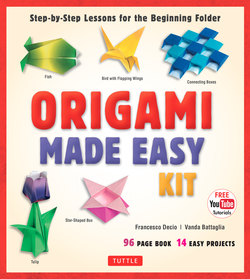Читать книгу Origami Made Easy Ebook - Vanda Battaglia - Страница 6
ОглавлениеINTRODUCTION
The Japanese word origami means “to fold paper.” It derives from the words ori (“to fold”) and kami (“paper”). Even though the word originally referred to the action of folding a piece of paper to create a model, “origami” has come to refer to the models themselves. An enormous variety of figures can be made using a combination of a small number of basic origami folds.
The practice of origami is over a thousand years old and is closely bound to the invention of paper. Traditionally, paper making has been traced to China at the beginning of the second century CE. In 105 CE, Cai Lun, an official attached to the Chinese imperial court during the Han Dynasty (202 BCE–220 CE), presented a sheet of paper made from mulberry and other fibers to the emperor. In the seventh century, paper making moved east, first to Korea and then Japan, in about 610 CE, where it was perfected and reached a high level of refinement. Japanese hand-made paper, known as washi (from wa, “Japanese” and shi, “paper”), made from various natural materials, became intertwined with Japanese religion, culture and life. It was used to make various everyday objects, such as clothes, household goods and toys, as well as ritual objects. Even today, paper is used on every important occasion in the Land of the Rising Sun, and is held in the highest esteem. In Japan, origami is an art that is as highly regarded as painting and sculpture.
Origami came to the West fairly late, probably in the eighteenth or nineteenth century, where it quickly became popular but in a completely different way from in Japan. In the West, the art has also followed a long and interesting course. While it has been stripped of any religious significance, it has, nonetheless, demonstrated its extreme versatility in numerous fields and on every level, from the world of teaching, via geometry, to space technology. Today, we are familiar with a good many “classical” figures passed down by the Japanese. But the tendency in the West has been towards experimentation and forging new directions. Geometric and modular origami, in particular, the latter combining a number of identical pieces to form a complete model, have received strong support, and have been considerably enhanced by modern as well as traditional means of communication.
New techniques have been invented to solve old problems. These have been combined to form a modern theory of origami. Thanks to this, it is possible to devise highly complex models encapsulating a number of subjects of mathematical and technical interest. Nonetheless, origami continues to offer the majority of people the simple pleasure of a creative manual activity.
Folding is highly enjoyable. It is fun to fold boxes of various degrees of complexity for any number of occasions, to fold stars and decorations while playing with colors, to fold animals in both stylized and astonishingly realistic forms. In short, origami is play, for hands and for the mind. After learning the techniques of folding the bases—indispensable to creating your own models—you will be able to give free rein to your imagination and create new ones.
We often hear people say, “I bought a book on origami but I can’t figure out how to do it.” Often the difficulty lies in the language of origami. It is a highly symbolic language because it uses symbols to indicate the folds to be made. Knowledge of these symbols is fundamental to mastering this ancient paper art.
For a long time we had been aware that there was a need for a guide that would introduce the world of origami to beginners. Thus, we were delighted when a publisher suggested we write a short book that would explain and make the language of origami more easily understood.
This book starts at square one, as a beginners’ guide should, and is aimed at people who know nothing at all about origami. We lead you gradually through the sequence of learning and mastering the symbols as well the strategies and tricks necessary to read and understand origami diagrams. Above all, we want you to enjoy folding paper. We have done our best to provide you with a complete, clear and coherent overview.
Before you start on your origami journey, you need to find a solid surface on which to work and a large amount of paper to practice the instructions and, later, to fold the models. In this book, we first introduce the main folds, one by one, without asking you to create anything with them. The more you practice forming the individual folds, the quicker you will memorize the various moves and their associated symbols. By repeating the individual folds, over and over again, they will soon become second nature. This will give you the confidence to combine a series of folds later on.
You may become frustrated at the beginning. The steps may seem impossible to follow and exe-cute. But if you look carefully at the next step in the sequence, things will usually become clearer. If this strategy doesn’t help, put the work aside, sleep on it, and begin again from scratch the next day.
Folding paper is a highly relaxing, enjoyable and educational mental exercise. As the famous origami artist Akira Yoshizawa used to say, “When the hands are busy, the heart is at peace.”
Wishing you many peaceful folds.
Francesco and Vanda
